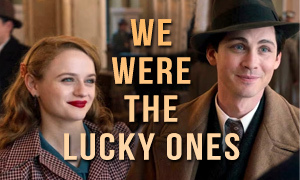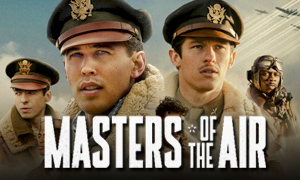Operation Finale: History vs. Hollywood
| REEL FACE: | REAL FACE: |
Oscar Isaac
Born: March 9, 1979 Birthplace: Guatemala City, Guatemala | Peter Malkin
Born: May 27, 1927 Birthplace: Israel Death: March 1, 2005, New York City, New York, USA Bio: Strongman, Expert in Disguises & Martial Arts |
Ben Kingsley
Born: December 31, 1943 Birthplace: Scarborough, Yorkshire, England, UK | Adolf Eichmann
Born: March 19, 1906 Birthplace: Solingen, Rhine Province, Kingdom of Prussia, German Empire Death: June 1, 1962, Ramla, Israel Execution by Hanging |
Joe Alwyn
Born: February 21, 1991 Birthplace: London, England, UK | Klaus Eichmann
Born: 1936 Birthplace: Berlin, Germany Bio: Son of Adolf Eichmann |
Haley Lu Richardson
Born: March 7, 1995 Birthplace: Phoenix, Arizona, USA | Sylvia Hermann
Bio: Girlfriend of Klaus Eichmann |
Peter Strauss
Born: February 20, 1947 Birthplace: Croton-on-Hudson, New York, USA | Lothar Hermann
Born: 1901 Birthplace: Quirnbach, Westerwaldkreis, Germany Death: July 1974, Coronel Suarez, Argentina Bio: Father of Sylvia Hermann |
Nick Kroll
Born: June 5, 1978 Birthplace: New York City, New York, USA | Rafi Eitan
Born: November 23, 1926 Birthplace: Ein Harod, Mandatory Palestine Bio: Leader of Operation Finale |
Michael Aronov
Born: May 1976 Birthplace: Tashkent, Uzbekistan | Zvi Aharoni
Born: February 6, 1921 Birthplace: Frankfurt (Oder), Germany Death: May 26, 2012, England, UK Bio: Interrogator with Knowledge of Argentina |
Lior Raz
Born: November 24, 1971 Birthplace: Jerusalem, Israel | Isser Harel
Born: 1912 Birthplace: Vitebsk, Russian Empire Death: February 18, 2003 Bio: Organizer of Operation Finale & Director of Mossad |
Torben Liebrecht
Born: December 3, 1977 Birthplace: Reinbek bei Hamburg, Germany | Yaakov Gat
Bio: Cool-Headed, Experienced Agent |
Greg Hill
| Moshe Tabor
Bio: Strongman & Technical Master |
Michael Benjamin Hernandez
| Shalom Dani
Bio: Master Forger |
What was Adolf Eichmann's role in the Holocaust?
Nazi SS-Obersturmbannführer (lieutenant colonel) Adolf Eichmann has been nicknamed "The Architect of the Holocaust". However, the agents involved in capturing him have noted that this gives him a little too much credit since there were a number of key organizers of the Final Solution. From 1939 to 1945, Eichmann, under orders from Reinhard Heydrich, masterminded the logistics involved in transporting millions of Jews to the ghettos and extermination camps during World War II. His experience for this job came from his previous employment at an oil company, where he meticulously organized the delivery of oil and other supplies to customers across Austria.
When Germany invaded Hungary in March 1944, Eichmann oversaw the deportation of the majority of the Jewish population, handling the logistics involved in transporting such a large number of people to the extermination camps, mainly to Auschwitz. In roughly four months time, approximately 437,000 of Hungary's 725,000 Jews had been exterminated.
As the end of the war neared, Adolf Eichmann is quoted as saying that he would "leap laughing into the grave because the feeling that he had five million people on his conscience would be for him a source of extraordinary satisfaction" (The Rise and Fall of the Third Reich). The total number of Jews killed in the Holocaust would end up being between five and six million.
Did Israeli intelligence agent Peter Malkin lose members of his family in the Holocaust?
Yes. In the movie, Ben Kingsley's character asks Peter Malkin (Oscar Isaac), "Who did we take from you, Peter? Who did you lose?" The Operation Finale true story reveals that Israeli Mossad agent Peter Malkin lost many loved ones in the Holocaust, including his sister Fruma and her children. "I was born in Israel," said Malkin during an interview on the Charney Report TV show. "After one year, I went to Poland until the age of eight, and [in 1936] we escaped again. My mother left some relatives, my sister, three children, and a brother. There was no way to take them out. ... We didn't succeed to take out my sister and [her three] children, and about 180 relatives. And we went back to Israel and they died in Auschwitz." Peter, his mother, and a brother returned to Israel in 1937 and survived.
Had U.S. troops captured Adolf Eichmann at the end of World War II?
Yes. While conducting our Operation Finale movie fact-check, we learned that the real Adolf Eichmann was in U.S. custody at the end of World War II, but the U.S. troops didn't know who they had. While being taken to various camps for SS officers, he produced forged papers that identified him as "Otto Eckmann". After he caught wind that his real identity had been discovered, he fled from a prisoner work detail in Cham, Germany. While on the run, he managed to obtain new papers that said he was "Otto Heninger". He moved around often, eventually settling in Lüneburg Heath in Northern Germany. Eichmann initially found work in the forestry industry. He lived there until 1950, leasing a small plot of land in Altensalzkoth.
How did Adolf Eichmann escape Germany in 1950?
While Adolf Eichmann was still living under a false identity in Northern Germany, the Nuremberg trials had taken place and various SS officers, including Auschwitz commandant Rudolf Höss, divulged damning evidence about Eichmann. As his exact role in the Holocaust became more widely known, his status as a fugitive grew.
With the help of Nazi sympathizers, Eichmann was able to obtain a landing permit for Argentina in 1948, along with a fake ID under the alias "Ricardo Klement". This helped him to secure an International Committee of the Red Cross humanitarian passport that allowed him to emigrate to the South American country of Argentina in 1950. Upon leaving Germany, he stayed in a number of monasteries across Europe that were doubling as safe houses. On June 17, 1950, he traveled by ship from Genoa, Italy and arrived in Buenos Aires, Argentina on July 14.
Did Adolf Eichmann really work in a Mercedes-Benz factory while he was hiding out in South America?
Yes. He worked at a Mercedes-Benz factory in Buenos Aires after first having a number of low-paying jobs. At Mercedes, Eichmann rose to the position of administrative clerk, which is in line with the movie.
Who alerted the Israeli government to Eichmann's whereabouts in Argentina?
After himself arriving in Argentina in July 1950, Eichmann sent for his family in 1952 and they settled in the capital city of Buenos Aires. While there, his son Klaus began dating a half-Jewish German girl named Sylvia Hermann in 1956. She had emigrated to Argentina with her family in 1938. Sylvia's father, Lothar Hermann, had escaped the Dachau concentration camp, where he was severely beaten and lost sight in one eye.
According to the true story, Lothar became suspicious after her daughter's boyfriend Klaus began telling Sylvia about his father's exploits as a Nazi. That, coupled with the last name "Eichmann", prompted Lothar to contact the prosecutor-general of the state of Hesse in West Germany, a man by the name of Fritz Bauer. Lothar then sent his daughter to gather more intelligence on Klaus's father, whom she encountered in person when she showed up at the Eichmann home. Acting on the promising evidence, Fritz Bauer spoke to Mossad director Isser Harel in 1957, and Harel put together a team of operatives to surveil the Eichmanns. This is all depicted rather accurately in the film.
What made Peter Malkin want to go after Adolf Eichmann in 1960?
In a 1996 interview with Leon Charney, Peter Malkin explained that Adolf Eichmann was the biggest war criminal who still hadn't been brought to justice. "After the Nuremberg trials, there haven't been so many stars later, and one of the stars was Eichmann, and for us Jews he was the biggest one. Not only Jews, I think for many people. He was the biggest man then. He was the head of the Jewish department, and he was responsible for sending millions of people, six million Jews and about another six million of other nationalities, and about one-half million of children, to death in the camps."
It wasn't common for the Mossad to carry out such an operation. Like the CIA, their main purpose was to gather intelligence from abroad. "The Mossad and the CIA is always bringing information from outside the country. ... This was an exception, the capture of Eichmann."
Did Israeli operative Rafi Eitan want to go after Eichmann from the start?
No. In an effort to bring more settlers to Israel during the early days of the Cold War, Mossad's focus was on screening the influx of immigrants coming into Israel. "We had to check everyone to understand if he was a spy or not," Eitan pointed out. "This was the first priority—not capturing Nazis." In the film, Eitan (portrayed by Nick Kroll) is shown arguing from the start for the importance of going after Eichmann. -The Daily Beast
Did Peter Malkin really pose as a painter while he was observing Adolf Eichmann's movements in South America?
Yes. After arriving in Buenos Aires in April 1960 as part of an eleven-person team, Mossad agent Peter Malkin posed as a painter while observing Eichmann's movements. He often used artistic endeavors as his cover while he was with Mossad. The identity helped to inspire a lifelong love for painting. Some of Malkin's paintings and drawings portray Eichmann and his capture. Many of these drawings and accompanying written memories are included in his book The Argentina Journal: Paintings and Memories.
How was Adolf Eichmann captured?
After living in Argentina for a decade, Adolf Eichmann was finally captured on the rainy night of May 11, 1960. Israeli Mossad agent Peter Zvi Malkin was part of an eleven-man team led by Mossad operative Rafi Eitan, who is portrayed by Nick Kroll in the movie. The team, which was made up mostly of Shin Bet agents, captured Eichmann, who was then going by the name Ricardo Klement, not far from his home on Garibaldi Street in the industrial community of San Fernando, Buenos Aires. They had arrived the month prior to observe Eichmann's movements.
Like in the movie, Mossad agent Peter Malkin was the first to engage Eichmann during the capture, saying to Eichmann in the only two words of Spanish he had learned, "Momentito, señor. One moment, sir." He restrained Eichmann in a neck lock and was quickly assisted by two fellow Mossad agents, who helped wrestle a frightened Eichmann to the ground. They got him into a waiting car where they concealed him on the floor under a blanket.
Did Peter Malkin really wear gloves so that he wouldn't have to put his bare hand over Eichmann's mouth?
Yes. This comes straight from his book. "The thought of placing my bare hand over the mouth that had ordered the death of millions, of feeling the hot breath and the saliva on my skin, filled me with an overwhelming sense of revulsion," wrote Malkin.
Did Mossad agent Peter Malkin have conversations with former Nazi Adolf Eichmann?
Yes. In researching the Operation Finale true story, we discovered that Mossad agent Peter Malkin indeed had conversations with Eichmann after Eichmann's capture. In his 2002 book The Argentina Journal, Malkin describes what it was like coming face-to-face with the man who was largely responsible for the murders of his own family members and millions of others. "Who is that man lying on the iron bed? What does he signify to me?" Malkin pondered.
He noted that Eichmann "did not look like a monster," which surprised him. He forced himself to talk with Eichmann, about which he commented, "Long an accomplished agent, I was at last becoming a human being." His conversations with Eichmann helped him to realize that the former Nazi was not a monster but a human being, which made Eichmann's actions during the war even harder to comprehend. Malkin later commented that "a monster can be excused for his behaviour . . . The problem is not how a monster could do it, but how a human being did it." -Peter Malkin Obituary
Were there hiccups in the operation in real life?
In fact-checking Operation Finale, we learned that the real operation went smoothly and mostly as planned, which of course wouldn't make for an exciting film. In real life, Eichmann's son later revealed that he and about 300 fellow fascists found out about the flight taking Eichmann out of Argentina, but they were half an hour too late to prevent the plane from departing. They figured out what likely had happened to Eichmann after having spent time the previous week searching hospitals and morgues for him. Team leader Rafi Eitan commented on Israel's Channel 2 investigative news program Uvda that operationally speaking, capturing Eichmann was "one of the easiest missions we did."
Was it difficult to get Adolf Eichmann to sign a document stating that he was willingly going to Israel to stand trial?
Yes, though the film makes it a little more climactic than it was in real life. As we explored the Operation Finale true story, we learned that getting Eichmann to sign the paper was indeed difficult and took a number of days. Peter Malkin details the struggle in his memoir Eichmann in My Hands. Eichmann's main argument against signing was that he did not want to be tried in Israel, figuring he'd certainly be found guilty and put to death. Eventually, during one of his almost nightly conversations with Israeli agent Peter Malkin, he came around and was willing to sign the document. Malkin reasoned that it was because he wanted credit for what he had done and wanted to be seen as a martyr for Nazi sympathizers. The document read:
Before he signed, Eichmann added the following to the document:
Did the Israeli agents really drug Adolf Eichmann to get him out of Argentina and back to Israel?
Yes. While fact-checking Operation Finale, we learned that after capturing him, the agents took him to a safe house outside Buenos Aires where he was held for ten days and fed kosher food. Before leaving for the airport, Dr. Yonah Elian drugged Eichmann so it would look like he had too much to drink. Peter Malkin had a fake identity set up for Eichmann, including an Israeli passport. At the airport, they told the Argentinian staff that Eichmann was an El Al airline flight attendant who had too much to drink and was being shipped home. The staff bought it and they boarded the plane to Jerusalem. Peter Malkin was not one of the six Israeli operatives on the plane with Eichmann. Malkin and four other agents remained on Argentine soil. Two left the next day on a plane bound for Uruguay. Unable to find a flight out, Malkin and the other two agents left Argentina on a train bound for Santiago, Chile. From there, they eventually made their way back to Israel by plane, arriving nearly three weeks after the mission was completed. -Peter Malkin Obituary
Was the doctor on the team a female in real life?
No. This is where the movie takes one of its biggest liberties. The movie character Dr. Hanna Elian (Mélanie Laurent), who safely sedates Adolf Eichmann to get him on a plane back to Israel, was male in real life. The real doctor's name was Dr. Yonah Elian. The gender was changed in order to create the character's fictional romance with Mossad agent Peter Malkin (Oscar Isaac). In his book, Eichmann in My Hands, the real Peter Malkin mentions a female agent named Rosa showing up in Argentina, but their was no romance between them. He described her as being unattractive and hard to take at times. She had been sent there to act as the wife of another agent.
Did the plane barely escape the Argentinian police and local Nazis before it took off?
No. The climactic scene at the end is almost entirely fiction. There was no nail-biting close call that involved Mossad agent Peter Malkin having to run a landing permit from the plane to the flight control tower. In fact, Peter Malkin didn't even go to the airport. The guards at the airport control point believed the story that the three men in the backseat, including Adolf Eichmann, were sleeping off a binge. They laughed about it and never asked to check IDs. The Israelis, posing as El Al Airline attendants like in the movie, loaded Eichmann onto the plane and it took off rather uneventfully. Similar to the film, a crewman on the plane who was a concentration camp survivor retreated to a private area and wept after learning Eichmann was on board.
Eichmann's son did later say that he and about three hundred fellow fascists had been desperately searching for his father. After checking morgues and local hospitals the week prior, they finally figured out the truth. However, a group of fascists and local police never showed up at the safe house as Eichmann was sneaking out, a close call that was added for the movie. Eichmann's son said that they made it to the airport about "half an hour too late. Had we known a little earlier we could have prevented the plane from taking off."
Peter Malkin and another agent stayed back at the safe house. They would help to clean it the next day and make it look exactly as it did when they arrived. -Eichmann in My Hands
Did Adolf Eichmann deny his role in the Holocaust?
He didn't deny orchestrating the deportation of millions of Jews, but he never admitted guilt and claimed that he was just following orders. "As far as this question is concerned, I can only say that I've never killed anyone." Eichmann said at his trial, referring to physically taking another person's life. "I had to obey orders. I had to do it."
"He said [in his trial], 'I was only responsible for the transportation,'" recalls ex-Israeli Mossad agent Peter Malkin. "So, it looks like, in those days, behind a desk, you could kill much more than with a pistol, and that's what he had done. He'd just send them to the camps." -Charney Report
Did Adolf Eichmann really sit inside a glass booth at his trial?
Yes. The booth was made of bulletproof glass and was meant to protect him from potential attempts on his life during the trial. Many people were in attendance at the trial, and it was highly publicized. Tickets were even given out. Watch the Adolf Eichmann Trial Video.
Were any other Nazis prosecuted by the Jewish people?
No. Adolf Eichmann was the only Nazi prosecuted by the Jewish people. Many had already been brought to justice at the Nuremberg trials that were held following World War II between 1945 and 1949. Those trials were conducted by the Allied forces under international law and the laws of war.
Was Adolf Eichmann really put to death?
Yes. At the conclusion of his trial, the "Architect of the Holocaust" was sentenced to death in December 1961 for crimes against the Jewish people. The Adolf Eichmann hanging took place in Israel on May 31, 1962. As stated at the end of the movie, he was cremated and his ashes were spread in the Mediterranean Sea so that he would have no final resting place.
Have any other movies been made about the capture of Adolf Eichmann?
Yes. Several other movies have been made about the capture of Adolf Eichmann, including the 1996 television film The Man Who Captured Eichmann starring Robert Duvall as the Nazi mastermind. Arliss Howard portrayed Malkin. The film was based on Peter Malkin's 1990 memoir Eichmann in My Hands.
How long was Peter Malkin a Mossad agent?
In an interview with Leon Charney, Peter Malkin stated that he spent 28 years in the Mossad, which is the Israeli equivalent of the CIA. Prior to working in the Mossad, Malkin had worked in the Shin Bet, the Israel Security Agency, whose motto is "Defender that shall not be seen" or "The unseen shield". While part of the Shin Bet, he served as an explosives expert. He was also skilled in martial arts and was a master of disguises. He eventually became the Head of Operations of the Mossad, which is "equivalent to a general," he explained.
In 1976, Malkin retired to the United States and became a well-regarded painter in Manhattan, where he lived with his wife, Roni, and their three children. It wouldn't be until 1991, well over a quarter century after Adolf Eichmann's trial, that Malkin's involvement in his capture became public knowledge. He would author two books, Eichmann in My Hands and The Argentina Journal. The latter features his paintings depicting the capture of Eichmann and his written memories of the experience. Malkin also acted as a private international consultant on anti-terrorism tactics. He passed away on March 1, 2005.
Peter Malkin Interview & Adolf Eichmann Trial Video
Peer deeper into the Operation Finale true story by watching an interview with the real Peter Malkin, who is portrayed by Oscar Isaac in the movie. Then watch the Adolf Eichmann trial videos that feature the former Nazi on the stand in Israel in 1961. At the end of the trial, he was found guilty. The Adolf Eichmann hanging was carried out on May 31, 1962.







